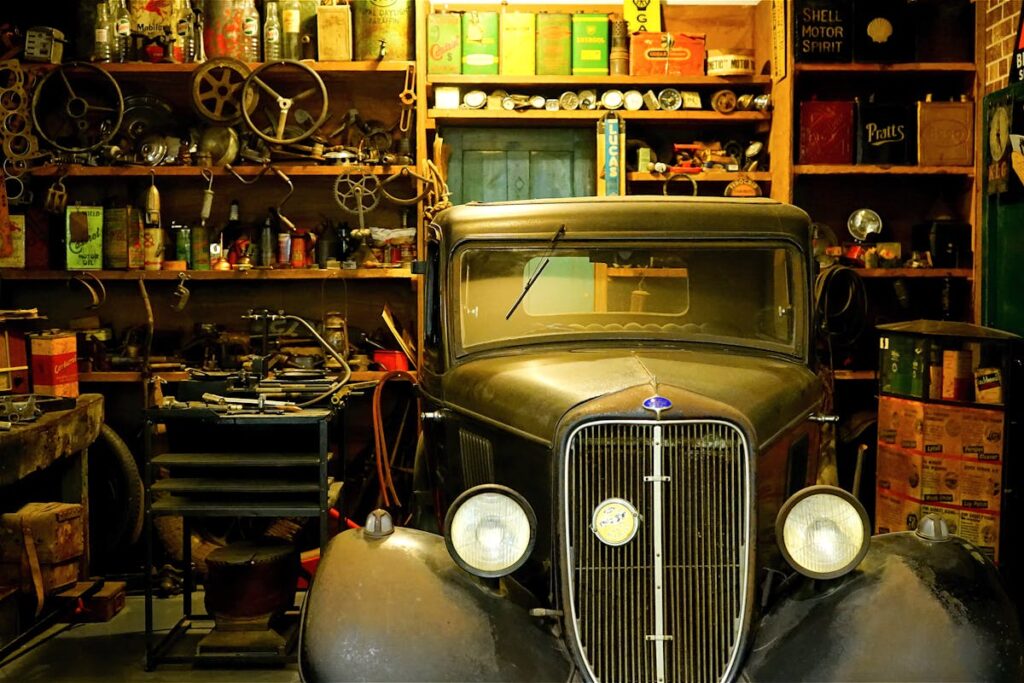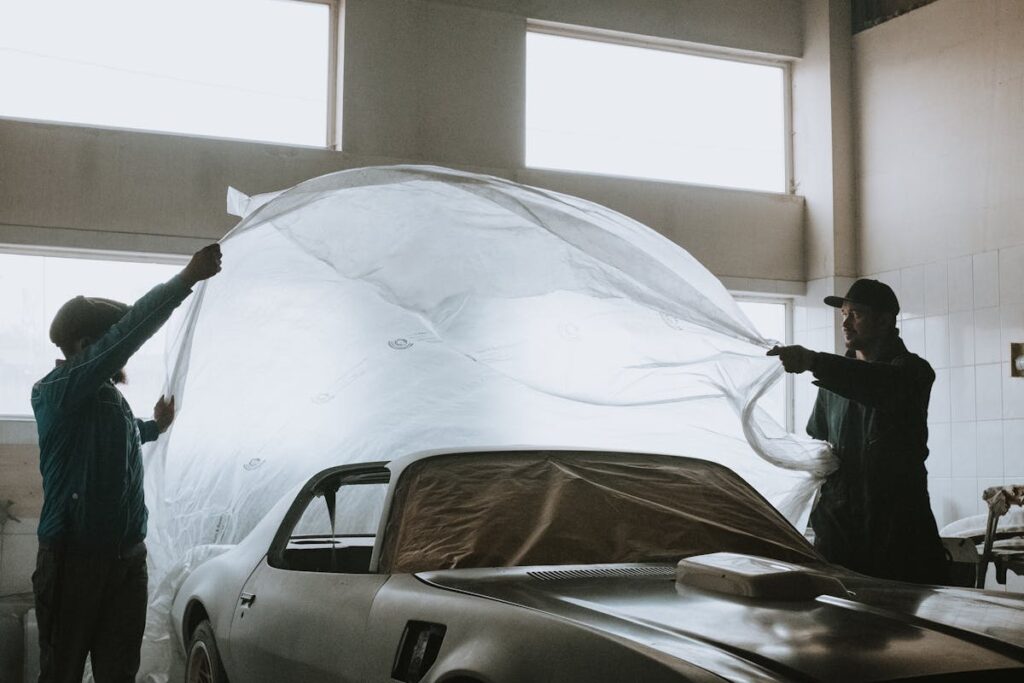In the domain of automotive history, vintage vehicles hold a special significance, blending artistry of the past with the marvels of engineering. However, preserving these classic gems is a delicate endeavor that requires an in-depth understanding of specialized techniques and practices. From regular maintenance checks and cleaning, to storage and detail work, each step in the process holds its unique challenges. Furthermore, the question of upgrading parts presents a delicate balance between maintaining authenticity and enhancing performance. As we navigate through these complexities, the goal remains clear: protecting the irreplaceable value and heritage of vintage cars.
Key Takeaways
- Regular maintenance checks, including engine oil replacement and use of high-quality fuel, are vital for vintage car preservation.
- Tire rotation, monthly air pressure checks, and monitoring tire condition ensure vehicle performance and longevity.
- Proper storage solutions, including climate control and humidity management, protect vintage cars from rust and corrosion.
- Detailing and cleaning, including paint restoration and upholstery care, help maintain the aesthetic appeal of vintage cars.
- Upgrading vintage car parts, handling common mechanical issues, and protecting the car’s value are crucial aspects of vintage car preservation.
Understanding Vintage Car Anatomy
A car enthusiast’s understanding of vintage car anatomy is the cornerstone to proficient preservation. The myriad of vintage car materials, each with their unique properties and maintenance requirements, demands an in-depth understanding. Materials such as cast iron, brass, leather, and wood were commonly used in these vehicles, and each comes with its unique set of preservation challenges.
Historical design influences play a notable role in shaping the anatomy of vintage cars. For instance, the art deco movement of the 1920s and 1930s considerably influenced car designs during this era. Cars embraced the streamlined, aerodynamic shapes, and bold, geometric forms, mirroring the optimism and rapid technological advancements of the time.
Understanding these influences helps enthusiasts comprehend why certain materials were used in specific eras and how these choices impact preservation. For example, brass, favored for its corrosion resistance and malleability, was a popular choice for early 20th-century car fittings but requires specialized care to prevent tarnishing.
Ultimately, a thorough understanding of vintage car anatomy, including vintage car materials and historical design influences, empowers car enthusiasts to preserve these automobiles effectively. This knowledge is not just about maintaining functionality but also respecting and preserving the historical integrity of these magnificent machines.
Regular Maintenance Checks
On the journey of vintage car preservation, regular maintenance checks serve as vital pit-stops. These checks, spanning from necessary engine care and tire maintenance to the practice of interior cleaning, are critical to keep these classic beauties running smoothly and looking their best. Let us explore these three key aspects of regular maintenance, which, when diligently followed, will guarantee that your vintage car remains a tribute to its glorious past.
Essential Engine Care Tips
Engine preservation, the heart of any vintage car, requires meticulous and consistent care. The engine is the lifeblood of your vintage car, and maintaining it is more than just a chore—it’s a labor of love. One area that demands particular attention is engine oil. It’s your vehicle’s lifeblood, keeping the engine running smoothly while minimizing wear and tear. Regularly replacing the engine oil, using a high-quality product, guarantees optimum performance and longevity.
Fuel quality is another essential factor in vintage engine care. Poor fuel quality can lead to engine deterioration, affecting the car’s overall performance. Ascertain you use high-quality fuel, as low-quality options often contain impurities that can cause damage over time.
In addition to these, regular inspections for any signs of rust, leaks or unusual noises are necessary. These indicate potential engine issues that require immediate attention. Ignoring these signs can lead to more serious, costly repairs down the line.
Tire Maintenance Essentials
Just as essential as engine preservation is the upkeep of your vintage car’s tires. Prolonging the life of your classic car involves more than just preserving its aesthetic components; it requires a keen eye for detail and a good understanding of tire maintenance essentials.
Tire rotation is a critical aspect of this process. Regular rotation helps to guarantee that your tires wear evenly, effectively extending their life and enhancing your vehicle’s performance. As a vintage car enthusiast, it is advisable to rotate the tires every 5,000 to 7,500 miles, depending on the tire’s condition and the vehicle’s usage.
Monitoring air pressure is another fundamental aspect of tire maintenance. Incorrect air pressure can lead to uneven tire wear, reduced fuel efficiency, and even tire failure. Consider checking your tires’ pressure at least once a month and before long trips. It’s recommended to check the pressure when the tires are cold, as heat can cause the pressure inside the tire to increase.
Investing time in tire maintenance can considerably contribute to a smoother ride, safer driving, and preservation of your precious vintage car. With these practices in place, you are assured of a well-maintained vintage vehicle with a long life ahead.
Interior Cleaning Practices
While tire maintenance greatly contributes to the longevity of a vintage car, equal attention must be paid to the interior of the vehicle. The interiors of vintage cars, often adorned with delicate fabrics and materials, require meticulous care to preserve their original magnificence.
Fabric care is an integral part of interior cleaning practices. Gentle vacuuming, spot cleaning, and occasional deep cleaning are necessary processes to maintain the integrity of the fabric. Avoiding harsh chemicals and choosing fabric cleaners that are suitable for the unique materials found in vintage cars is essential.
Upholstery conditioning, on the other hand, helps to prevent the leather or vinyl seats from cracking and fading. Quality conditioners not only clean the surface, but they also penetrate deep into the material, providing necessary moisture and protection. Regular conditioning can help maintain the vibrant color and supple feel of the seat materials, enhancing the overall appearance and comfort of the vehicle’s interior.

Proper Storage Solutions
In the domain of vintage car preservation, proper storage solutions emerge as a critical factor to contemplate. This involves more than merely parking your beloved classic in a garage or carport. The environment in which the vehicle is stored plays a significant role in maintaining its pristine condition.
The first consideration is climate control. A stable temperature prevents metal parts from contracting and expanding, which can lead to cracks and damage over time. Ideally, vintage cars should be stored in conditions where the temperature does not fluctuate drastically.
Next, one must consider humidity management. Excessive moisture in the air can lead to corrosion and rust, the arch-nemeses of any vintage car enthusiast. A dehumidifier can assist in maintaining an ideal level of humidity within the storage area, staving off potential damage.
Proper storage solutions are more than a luxury; they are a necessity to preserve the integrity and longevity of your vintage car. By taking these precautions, you are not just storing a vehicle; you are safeguarding a piece of history, a labor of love, and a reflection of bygone eras of automotive excellence.
Detailing and Cleaning Tips
Having considered the importance of proper storage solutions, it’s time to cast our focus on detailing and cleaning tips, another significant aspect of vintage car preservation. A meticulous and knowledgeable approach to detailing and cleaning not only enhances the car’s aesthetic appeal but also safeguards its longevity.
Firstly, let’s explore paint restoration techniques. Over time, the paint on vintage cars may degrade due to exposure to the elements. High-quality cleaning compounds and clay bars can help remove surface contaminants. For faded or scratched paint, consider using a dual-action polisher, followed by a protective layer of wax to restore the car’s original shine.
Equally important is upholstery care, particularly for vintage cars with original leather or fabric interiors. Regular vacuuming will prevent dirt accumulation. Use specialized cleaning solutions suitable for the material. For leather interiors, conditioning is key to prevent cracking and drying out.
Upgrading Vintage Car Parts
Every vintage car owner’s journey inevitably leads to the important decision of upgrading car parts. This process requires a meticulous balance between maintaining the vehicle’s vintage aesthetics and enhancing its functionality.
Modern replacements and aftermarket options offer viable solutions for worn-out components. These parts provide a functionality balance, often improving performance while keeping the classic look intact. Performance upgrades, however, need careful consideration. They can boost the vehicle’s capabilities, but might detract from the original, authentic feel of your vintage treasure.
Restoration techniques play a significant role in preserving the car’s old-world charm. Customization possibilities are endless, allowing car enthusiasts to express their unique taste and style. Yet, sourcing parts can prove to be a challenging task, requiring a blend of patience, resourcefulness, and a keen understanding of the car’s specifications. For those on the lookout for authentic components, finding original parts for vintage car restoration can be an invaluable resource in this pursuit.
Compatibility considerations are paramount when upgrading vintage car parts. Every component needs to be in sync with the vehicle’s design and functionality to avoid complications in the future.
Lastly, a thorough cost analysis is essential. It’s not just about purchasing the part; installation, possible modifications, and maintenance costs should also be factored in. The whole process, while intricate, is undeniably an invigorating part of the vintage car ownership experience.
Handling Common Mechanical Issues
Owning a vintage car often entails dealing with some common mechanical issues. These issues can range from brake system failures to transmission issues, and from suspension problems to exhaust system malfunctions. Knowing how to handle these issues can go a long way in preserving your vintage car.
The brake system, often plagued by worn pads or leaky lines, requires regular inspections and maintenance. Similarly, the electrical components, such as the ignition system, need to be checked for faulty wiring or old batteries. Fuel system issues can be avoided with consistent carburetor maintenance and guaranteeing clean fuel, while transmission issues demand expert attention.
The suspension system holds the key to a smooth ride, and addressing problems early on can prevent further damage. The exhaust system, too, can cause problems if not maintained, leading to poor performance and possible health risks. The cooling system helps prevent overheating, a common issue in vintage cars, so keep an eye on the radiator and coolant levels.
Lastly, differential care is essential, as this component is responsible for the proper rotation of your wheels. By tackling these common mechanical issues head-on, you can guarantee your vintage car runs smoothly for years to come.
Protecting Your Car’s Value
Preservation is the cornerstone of maintaining the value of your vintage car. This involves more than just regular maintenance and repairs; it also means staying informed about value appraisal and market trends. An accurate value appraisal not only provides an estimate of the current worth of your vehicle but also indicates where improvements can be made to increase its value. If you’re considering acquiring a vintage car, it’s important to understand key aspects of buying and evaluating these vehicles.
To protect your investment, consider these factors: rarity, condition, originality, and provenance. Rarity and provenance are elements that cannot be controlled; however, the condition and originality are aspects that can be influenced by appropriate care and restoration.
Understanding market trends is also essential. For instance, certain models may increase in value due to shifts in consumer interest or the release of a new model. Staying updated about these trends can help you make informed decisions about when to sell or hold onto your vehicle.
In essence, preservation goes beyond physical upkeep; it also encompasses a thorough understanding of your vehicle’s worth and the market dynamics. With this understanding, you can guarantee that your vintage car remains a valuable asset.
Frequently Asked Questions
Whats the Appropriate Insurance Coverage for My Vintage Car?
The appropriate insurance coverage for your vintage car should include a thorough classic car insurance policy. These specialized vintage vehicle policies offer tailored coverage for the unique needs and risks associated with classic automobiles.
How Often Should Vintage Cars Be Driven to Maintain Good Condition?
To maintain ideal condition, vintage cars should be driven at least once every two weeks. Regular movement aids in preserving mechanical components and preventing parts from seizing due to prolonged inactivity, ensuring vehicle maintenance.
Can Vintage Cars Be Used for Long-Distance Travel?
While vintage cars can be used for long-distance travel, their reliability may vary due to age and condition. Following vintage travel tips, such as regular maintenance and careful driving, can enhance their long-distance performance.
What Are the Best Vintage Car Shows or Events to Attend?
Pebble Beach Concours d’Elegance and Goodwood Revival are highly recommended for their diverse car show experiences, often showcasing vintage car clubs. Both events provide a unique platform for appreciating the beauty and history of vintage vehicles.
How Can I Learn More About the Historical Background of My Vintage Car?
To learn more about your vintage car’s historical background, utilize various research resources such as automotive history books, online car enthusiast forums, and historical documentation available from the car’s manufacturer or automotive history archives.

